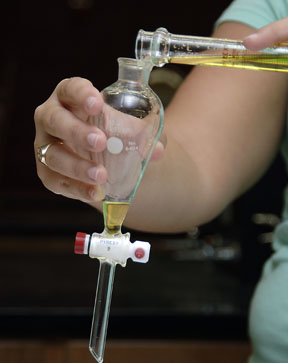|
The concept of concentration is very wide and diverse, while still remaining one of the most useful and common tools in the chemist’s box of skills. Considering a pure material and an impurity; when only the pure material exists, its concentration is maximized and addition of the impurity leads to a change in concentration as the system gets bigger. With continued addition of the impurity, the concentrations will continue to change respectively for each material. Most of the time, the concentration of one species is considered at one time, such as molarity, volume % and mass %, where the quantity of species for consideration is the numerator and the quantity of total system is the denominator for the fractional ratio. Molarity: M = moles of species for consideration/total Liters of solution Although volume % is widely used, the actual quantities can depend on the temperature and pressure of the species in the system, so volume % can vary. Mass % on the other hand, does not change with temperature and pressure. For example, in the species Mg(BH4)2 the mass % of Mg would be: mass%(Mg) = mass of Mg/mass of Mg(BH4)2 = 24.31g/54.01g = 0.45 ~ 45%. The definition and use of terms such as solute, solvent, solution, homogenous and inhomogenous have importance when considering concentration. In the USA and many other places in the world, when considering a delicious alcoholic beverage, usually the concentration of pure alcohol in the drink is the proof. The proof of a drink is exactly equal to twice the volume %, so pure ethanol would have a theoretical proof of 200, which is why Bacardi 151 packs so much punch. The proof of beer and wine are low, usually around 10-12 and 24-29, respectively, so percent is used more (Most beer is about 5% ethanol, wine is about 12-15%). Historically, southern moonshine has always been an endeavor in the purification of fermentation derived ethanol drinks with extremely high proofs. It is worthy to note at this point that the solutions used in this lab are combinations of 95% ethanol and water. Ingestion of ethanol at that concentration is capable of doing damage to human mouths, throats and internal organs, accidental ingestion could be cause for emergency medical attention, so appropriate measures should be taken when handling the solutions to avoid inhalation, skin contact or ingestion. Equally harmful diethly ether and sodium acetate that necessary for separation require the same care when handling. Appropriate measures should be taken when handling the solutions to avoid inhalation, skin contact or ingestion. Dealing with liquids in the chemistry lab always requires containers and tools that can collect, dispense, measure and hold exact quantities of liquid. A useful tool for handling liquids is the separatory funnel, which has a pourable top on the large end and a narrow valve at the small end.
In the 1980’s a patent was developed that separated ethanol from water by seperatory funnel, rather than by distillation. It involves the use of several chemical reactions and techniques that can not be recreated exactly in the chemistry teaching lab, but the basic concepts of the patent can be demonstrated by separating a mixture of water and ethanol. At first the ethanol will be homogenous with the water and mix well, but upon addition of an organic solvent that binds ethanol, it will separate as the upper layer and can be collected. When optimized, a process like this could have profitable use in beer, wine or alcohol or even pure ethanol industries.
|
 |
Proof of Alcohol

